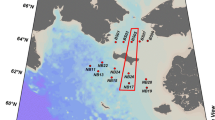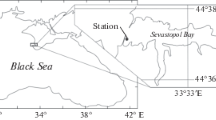Abstract
Picoplankton, both prokaryotic and eukaryotic, are distinguished from other aquatic organisms by their small size (0.1–2.0 μm). Such organisms were recovered from waters of a small oligotrophic lake using screens, filters, and high-speed centrifugation. The majority of the picoplankton were unable to form visible colonies on common media. Cells examined in thin sections by electron microscopy showed that 60–75% of the cells had an average diameter after dehydration of 0.48–0.51 μm. The maximum dimensions of the rest of the cells ranged from 0.56–1.81 μm. Using details of ultrastructure, cells were classified as prokaryotic or eukaryotic. Phototrophs present included two cyanobacterial morphotypes (5–6%) and two eukaryotic algae (less than I%). The arrays of intracytoplasmic membranes in 18–20% of the cells were suggestive of methanotrophic rods and chemoautotrophs. Relatively few prosthecate bacteria were observed in the water column samples. The smallest cells (1–2%) contained magnetosomes, the presence of which were confirmed by x-ray spectroscopy. Iron was also detected in the envelopes of some rod shaped cells by the same technique. The study of in situ picoplankton populations using TEM coupled with other techniques may provide better understanding of picoplankton biomass.
Similar content being viewed by others
References
Adirondack Lake Survey Reports (1987) Adirondack Lake Survey Corporation, Ray Brook, NY, 12977
Andreoli CN, Rascio F, Dalla Vecchia, Talarico L (1989) An ultrastructural research on natural populations of picoplankton from two brackish water environments in Italy. J Plankton Res 11:1067–1074
American Public Health Association (1989) Standard methods for the examination of water and waste water. 17th Ed., American Public Health Association, Washington, DC
Bae HC, Cota-Robles SH, Casida LE (1972) Microflora of soil as viewed by transmission electron microscopy. Appl Microbiol 23:637–648
Baxter M, Jensen TE (1980) Uptake of magnesium, strontium, barium and manganese by Plectonema boryanum (Cyanophyceae) with special reference to polyphosphate bodies. Protoplasma 104:81–89
Beveridge TJ (1989) The structure of bacteria. In: Poindexter JS, Leadbetter ER (eds) Bacteria in nature, vol. 3: Structure, physiology and genetic adaptability. Plenum Press, New York, pp 1–15
Blakemore RP, Blakemore NA, Bazylinski DA, Moench TT (1989) Magnetotactic bacteria In: Staley IT, Bryant MA, Pfennig W, Holt JG (ededs) Bergey's manual of systematic bacteriology, Vol. 3, Section 20E. Williams and Wilkins, London, pp 1882–1889
Booth KN, Sigee DC, Belliger E (1987) Studies on the occurrence and elemental composition of bacteria in freshwater plankton. Scanning Microscopy 1:2033–2042
Caldwell DE (1977) The planktonic microflora of lakes. CRC Critical Reviews in Microbiology, pp.305-370
Chetina EV, Suzina NW, Fikhte BA, Trotsenko YA (1981) Influence of culture conditions on organization of the membrane apparatus in Methylomonas methanica. Microbiology 51:257–254
Colwell RR, Brayton PR, Grimes DJ, Roszal DB, Huq SA, Palmer LM (1985) Viable but non-culturable Vibrio cholerae and related pathogens in the environment: Implications for the release of genetically engineered microorganisms. Biotechnology 3:817–820
Corpe WA, Jensen TE (1986) Fine structure of cytoplasmic inclusions of some methylotrophic bacteria from plant surfaces. Arch Microbiol 145:107–112
Corpe WA, Jensen TE (1991) Major antigens in Methylobacterium species and their location in cells using immunoelectron microscopic methods. Cytobios 67:117–126
Costerton JW (1979) The role of electron microscopy in the elucidation of bacterial structure and function. Ann Rev Microbiol 33:459–479
DaviesSL, Whittenbury R (1970) Fine structure of methane and other hydrocarbon utilizing bacteria. J Gen Microbiol 61:227–232
DeBoer WE, Hazeau W (1972) Observations on the fine structure of a methane oxidizing bacterium. Ant Van Leeuwenhoek J Microbiol Serol 38:33–47
Fahnenstiel GL, Sicko-Goad L, Scavia D, Stoermer E (1986) Importance of picoplankton in Lake Superior. Can J Fish Aquat Sci 43:235–240
Hanson RS, Wattenberg EV (1991) Ecology of methylotrophic bacteria. In: Goldberg I, Rokem JS (eds) Biology of methyotrophs. Butterworth-Heineman Publishing, Boston, pp 325–348
Harold FM (1966) Inorganic polyphosphates in biology: Structure, metabolism and function. Bacteriol Rev 30:772–794
Herman EM (1988) Immunocytochemical localization of macromolecules with the electron microscope. Ann Rev Plant Physiol Plant Mol Biol 39:139–155
Hobbie JE, Daley RJ, Jaspar S (1977) Use of nuclepore filters for counting bacteria by epifluorescence microscopy. Appl Environ Microbiol 33:1225–1228
Hyder SL, Meyers A, Cayer ML (1979) Membrane modulation in a methylotrophic bacterium Methylococcus capsulatus (Texas) as a function of growth substrate. Tissue and Cell 11:597–610
Jensen TE, Corpe WA (1991a) Ultrastructure of methylotrophic microorganisms. In: Goldberg I, Rokem JS (eds) Biology of methylotrophs. Butterworth-Heinemann Publishing, Boston
Johnson PW, Sieburth JMcN (1979) Chroococcoid cyanobacteria in the sea: A ubiquitous and diverse photo biomass. Limnol Oceanogr 24:928–935
Johnson PW, Sieburth JMcN (1982) In situ morphology and occurrence of eukaryotic phototrophs of bacterial size in the picoplankton of estuarine and oceanic waters. J Phycol 18:318–327
Joint IR, Pipel RK (1984) An electron microscope study of a natural population of picoplankton from the Celtic Sea. Mar Ecol Prog Ser 20:1123–1118
Kulaev IS, Vagabod VM (1983) Polyphosphate metabolism in microorganisms. Adv Microbiol Physiol 24:83–171
Larsson KC, Weibull C, Gronberg G (1978) Comparison of light and electron microscopic determinations of the number of bacteria and algae in lake water. Appl Environ Microbiol 35:397–404
Luft JH (1961) Improvements in epoxy resin embedding methods. J Biophys Biochem Cytol 9:409–414
MacDonnell M, Hood MA (1982) Isolation and characterization of ultramicrobacteria from a gulf coast estuary. Appl Environ Microbiol 43:566–571
Morita RY (1982) Starvation-survival of heterotrophs in the marine environment. Adv Microbiol Ecol 6:171–197
Moench TT, Konetzka WA (1978) A novel method for isolation and study of a magnetotactic bacterium. Arch Microbiol 119:203–212
Moench TT (1988) Bilophococcus magnetotacticus, new genus, a motile magnetic coccus. Antonie van Leeuwenhoek 54:483–496
Novitsky JA, Morita RY (1976) Morphological characterization of small cells resulting from nutrient starvation of a psychrophilic marine vibrio. Appl Environ Microbiol 32:617–622
Paerl HW (1980) Attachment of microorganisms to living and detrital surfaces in fresh water systems. In: Bitton C, Marshall KC (eds) Adsorption of microorganisms to surfaces. Wiley and Sons, New York, pp 375–402
Pankratz HS, Bowen CC (1963) Cytology of blue-green algae. I. The cells of Symploca muscorum. Am J Bot 50:387–389
Patt TE, Cole GC, Bland J, Hanson RS (1974) Isolation and characterization of bacteria that grow on methane and organic compounds as sole sources of carbon and energy. J Bacteriol 120:955–964
Poindexter JS (1981) Oligotrophy, fast and famine existence. Adv Microbiol Ecology 5:63–69
Pomeroy LR (1984) Significance of microorganisms in carbon and energy flow in marine systems. In: Klug MJ, Reddy CA (eds) Current perspectives in microbiol ecology. Amer Soc Microbiol, Washington DC, pp 405–411
Preiss J (1989) Chemistry and metabolism of intracellular reserves. In: Poindexter JS, Leadbetter ER (eds), Bacteria in nature, vol. 3: Structure, physiology and genetic adaptability. Plenum Press, New York, pp 189–258
Proctor HM, Norris JR, Ribbons DW (1969) Fine structure of methane utilizing bacteria. J Appl Bacteriol 32:118–121
Scott D, Brannan J, Higgins IJ (1981) The effect of growth conditions on intracytoplasmic membranes and methane monooxygenase activities in Methylosinus trichosporium OB3b. J Gen Microbiol 125:63–72
Sicko-Goad L, Stoermer EF (1984) The need for uniform terminology concerning phytoplankton cell size fractions and examples of picoplankton from the Laurentian Great Lakes. J Great Lakes Res 10:90–93
Sieburth JMcN, Johnson PW (1989) Picoplankton ultrastructure: A decade of preparation for the brown tide alga, Aureococcus anophageferrens. In: Cosper EM, Bricelj VM, Carpenter EJ (eds) Novel phytoplankton blooms: Causes and impacts of recurrent brown tides and other unusual blooms. Coastal and Estuarine Studies, Springer-Verlag, pp 1–21
Stempak JB, Ward RT (1964) An improved staining method for electron microscopy. J Cell Biol 22:697–701
Stockner JG (1988) Phototrophic picoplankton: An overview from marine and freshwater systems. Limnol and Oceanogr 33:765–775
Stockner JG, Antia NG (1986) Algal picoplankton from marine and freshwater ecosystems: A multidisciplinary perspective. Can J Fish Aquat Sci 43:2472–2503
Takahashi M, Kikuchi K, Hara Y (1985) Importance of picocyanobacteria biomass (unicellular, blue green algae) in the phytoplankton population of the coastal waters off Japan. Mar Biol 89:63–69
Titus JA, Reed WM, Pfister RM, Dugan PR (1982) Exospore formation in Methylosiuus trichosporium. J Bacteriol 149:354–360
Vatintsev KK, Meshceryakova AI, Popvskaya GI (1972) The importance of ultrananno planktonic algae in the primary production of Lake Baikal in the summer. Gidrobiol Zh 8:21–27
Waterbury JB, Watson SW, Guillard RRL, Brand LW (1979) Widespread occurrence of a unicellular, marine, planktonic cyanobacterium. Nature 277:293–294
Witzel KP (1990) Approaches to bacterial population dynamics. In: Overbeck J, Chrost RJ (eds) Aquatic microbial ecology, biochemical and molecular approaches. Springer Verlag, New York, pp 96–128
Author information
Authors and Affiliations
Rights and permissions
About this article
Cite this article
Corpe, W.A., Jensen, T.E. An electron microscopic study of picoplanktonic organisms from a Small Lake. Microb Ecol 24, 181–197 (1992). https://doi.org/10.1007/BF00174454
Received:
Revised:
Issue Date:
DOI: https://doi.org/10.1007/BF00174454




